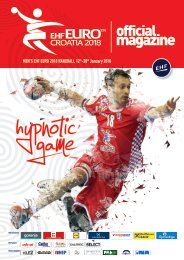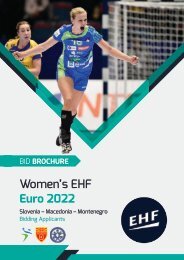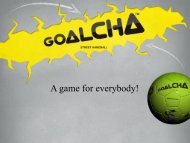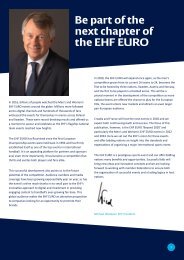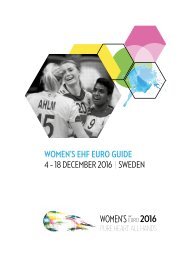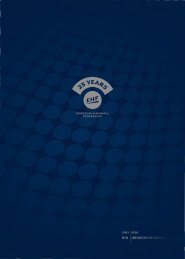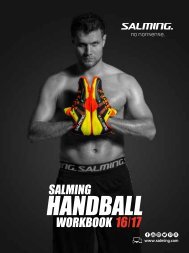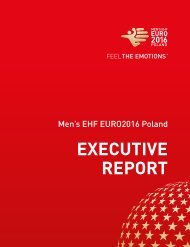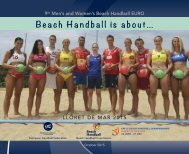ehf_25yers_book_webversion
Create successful ePaper yourself
Turn your PDF publications into a flip-book with our unique Google optimized e-Paper software.
EURO in Slovenia would not be break any records<br />
in terms of tickets sold. For this, the capacities<br />
of Hala Tivoli in Ljubljana and the other<br />
arenas at Koper, Celja and Velenje were just not<br />
big enough. But the ECh was again well organised<br />
and boasted a great atmosphere. Some 88<br />
percent of tickets were sold, and the organisation<br />
committee directed by Zoran Jankovic was<br />
showered with praise from all sides. With welltrained<br />
security guards at hand, the organisers<br />
retained tight control of the politically charged<br />
encounters between the nations of ex-Yugoslavia,<br />
which had been classified as high-risk matches.<br />
“The organisers have invested a lot of time<br />
and money,” lauded Helmut Höritsch, the EHF’s<br />
Senior Development Manager.<br />
On the other hand, the EHF had to deal with<br />
criticism of the playing format used in Slovenia<br />
as it emerged that the rule change resulting<br />
in the “fast middle” had made the game much<br />
faster and hence made even more demands on<br />
the players’ physical strength. In view of this development,<br />
the EHF had already added one additional<br />
rest day compared with the 2002 ECh.<br />
“The players are of course exposed to enormous<br />
levels of stresses and strains,” said Höritsch.<br />
“The ECh, however, is what it is: a top product.”<br />
In due course, the EHF reacted to the new conditions<br />
by significantly extending the tournament<br />
in order to provide more time for regeneration.<br />
While, initially, the tournament had been played<br />
over ten or eleven days, the 2016 ECh in Poland<br />
lasted 17 days – a concession to safeguard the<br />
professional players‘ physical health.<br />
Where media coverage was concerned, the<br />
2004 event in Slovenia as well as later tournaments<br />
continued the trend of a steadily increasing<br />
viewership. In 2004, the EHF EURO matches<br />
attracted about 709 million viewers in a total of<br />
190 countries. Two years later, this figure rose to<br />
760 million spectators. The 2010 competition<br />
held in Austria was the first to hit the milestone<br />
of a television audience of one billion. In 2012,<br />
in Serbia, the cumulative number of spectators<br />
almost reached 1.5 billion. The development<br />
in the social media was likewise breath-taking:<br />
during the EHF EURO 2010 in Austria, the<br />
<strong>ehf</strong>-euro.com internet platform was accessed<br />
by a new record of about ten million users. Almost<br />
one million fans watched videos on the<br />
EHF‘s YouTube channel. These figures reflect the<br />
great appeal that the EHF EURO had attained by<br />
that date as the “most challenging tournament in<br />
global handball”. At the same time, the number<br />
of TV stations and journalist accreditations kept<br />
rising. 800 journalists were accredited in Switzerland,<br />
in Austria even around 1200.<br />
75



